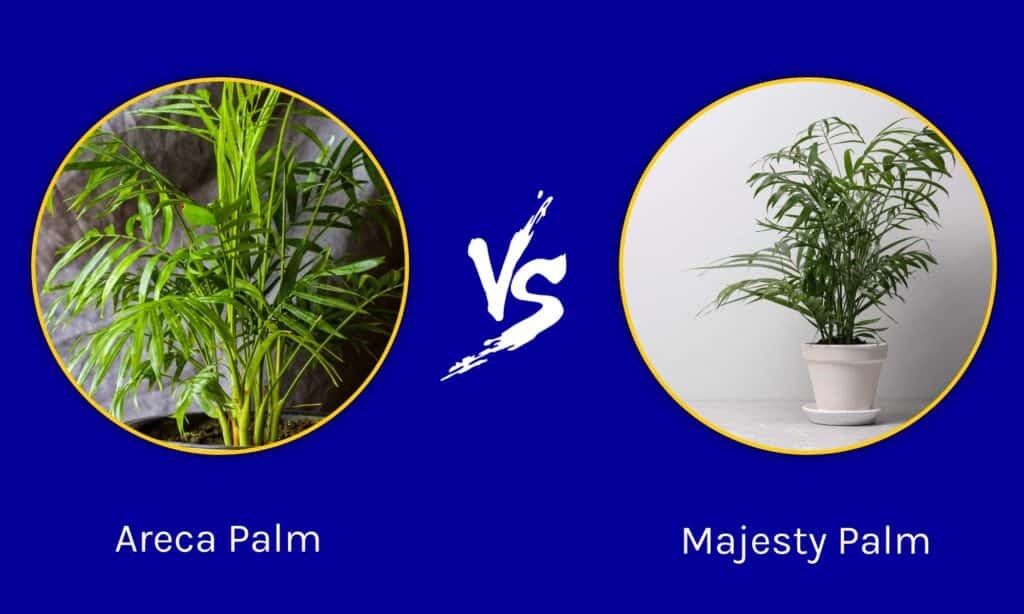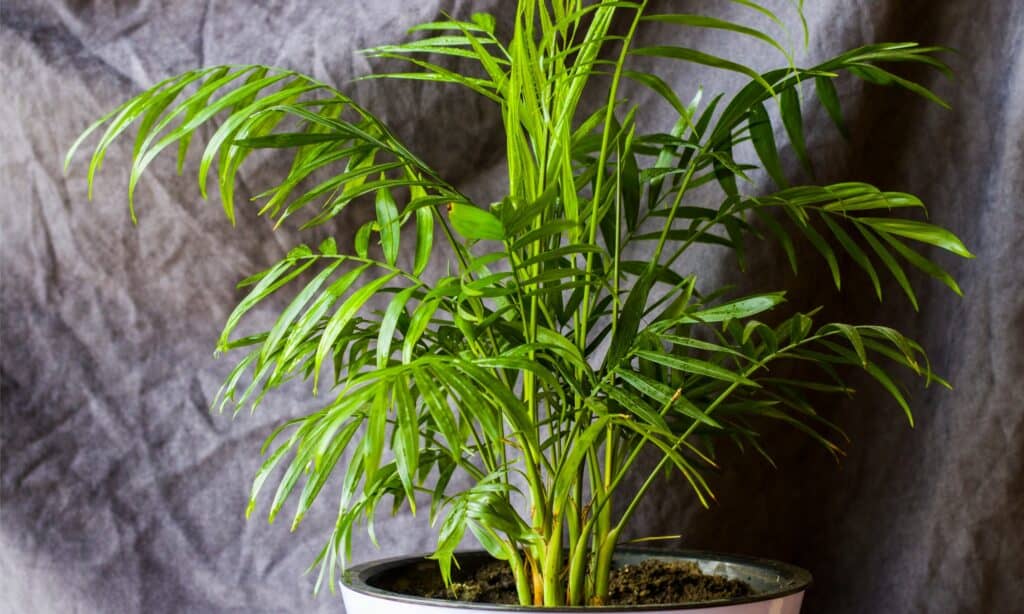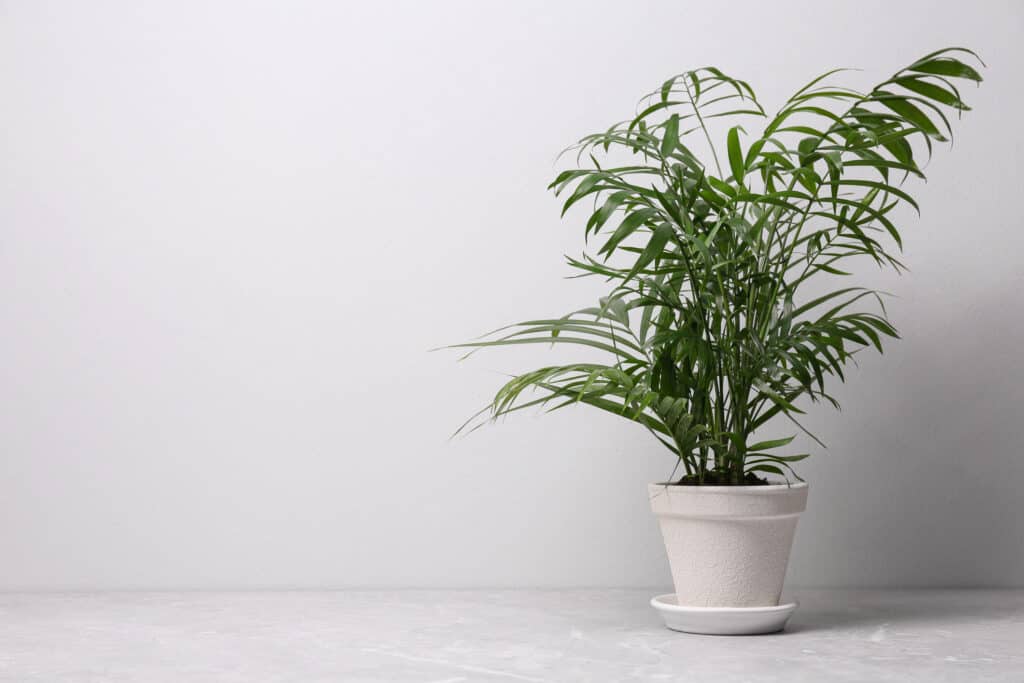Areca and majesty palms are popular ornamental or house plants thanks to their beautiful appearance. While things are easy with majesty palms because there are only one species (Ravenea rivularis) that bears this common name, things get a bit more complicated with areca palms.
The term “areca palm” refers to a lot of palm species. It may refer to any of the 51 species in the Areca genus of palms that grow in humid tropical forests. Some of these species are Areca catechu, known as betel palm, Areca andersonii, Areca concinna, Areca glandiformis, and Areca novohibernica.
This term is most commonly used among plant enthusiasts in regard to a flowering plant called Dypsis lutescens. It is part of the Dypsis genus of slender, evergreen palms. Since this is the most common palm used as an ornamental or house plant, we’ll compare the majesty palm with the Dypsis lutescens areca palm.
So how can we distinguish between an areca palm and a majesty palm? Let’s find out!
Comparing Areca Palm vs. Majesty Palm

| Areca Palm | Majesty Palm | |
|---|---|---|
| Classification | Kingdom: Plantae Clade: Tracheophytes Clade: Angiosperms Clade: Monocots Clade: Commelinids Order: Arecales Family: Arecaceae Genus: Dypsis Species: Dypsis lutescens | Kingdom: Plantae Clade: Tracheophytes Clade: Angiosperms Clade: Monocots Clade: Commelinids Order: Arecales Family: Arecaceae Genus: Ravenea Species: Ravenea rivularis |
| Common names | Butterfly palm, golden cane palm, yellow palm, bamboo palm | Majestic palm |
| Plant type | Flowering plant; evergreen, dioecious palm | Tree; evergreen, dioecious palm |
| Native to | Madagascar | Madagascar |
| Description | – Height: 4 – 10 feet indoors; 20 – 39 feet – Fronds length: 6 ft 7 in – 9 ft 10 in – Arched, pinnate fronds with 40 – 60 pairs of leaflets; – Has panicles of yellow flowers in summer – Light, bamboo-like stems | – Height: 5 – 15 feet indoors; can reach 98 feet in its natural habitat) – Upward-arching, pinnate, reduplicate leaves with linear leaflets; brown stems |
| Uses | Grown as an ornamental garden plant in tropical and subtropical regions and as a houseplant in other areas | Popular houseplant |
| Growth and care | – Light: require much sunlight, best left in indirect sunlight but can also enjoy direct sunlight -Soil: Moist but well-drained; 6.1 – 6.5 pH soil – Water: require regular watering but not overwatering; sensitive to fluoridated water – Temperature: 65 – 75 degrees Fahrenheit – Fertilizing: require fertilizing during spring and summer | – Light: require much sunlight, best left in indirect sunlight – Soil: moist but well-drained, 5.0 – 6.0 pH soil – Water: require regular watering but not overwatering – Temperature: 65 – 85 degrees Fahrenheit – Fertilizing: once or twice during the growing season; may require fertilizers rich in magnesium and iron |
| Hardiness zone as per USDA | 10-11 | 10-11 |
| Conservation status | Near Threatened | Vulnerable |
The Key Differences between Areca Palm and Majesty Palm
Areca palms and majesty palms are well-known among plant enthusiasts! However, even experts may sometimes mistake one for another because they have roughly the same appearance.
That’s why we’re here! We’ve compared areca palms with majesty palms and found key differences between the two!
Areca Palm vs. Majesty Palm: Classification and Plant Type

Areca palms bloom in late spring or summer and produce small yellow flowers.
©iStock.com/Tamar Dundua
One of the most important distinctions between an areca palm and a majesty palm is that they’re part of different genera. Both species are in the Arecaceae family of perennial plants. They are further classified into Dypsis (for the areca palm) and Ravenea (for the majesty palm). Both genera consist of evergreen palms native to Tanzania, Madagascar, and various Indian Ocean islands.
Although areca palms and majesty palms are part of the Arecaceae family of flowering plants, majesty palms rarely bloom and aren’t officially classified as flowering plants. Only large majesty palms living outdoors may bloom once they’re fully grown. In contrast, areca palms bloom in late spring or summer and produce small yellow flowers.
Both plants are dioecious, which means they have both male and female specimens.
Areca Palm vs. Majesty Palm: Description
Areca palms usually grow between 4 to 10 feet tall indoors and 20 – 39 feet outdoors. They have smooth stems that sometimes have a golden color. They have arched, pinnate fronds resembling bamboo leaves that can grow about 6 ft 7 in – 9 ft 10 in long. Each frond has approximately 40 to 60 pairs of leaflets.
Although majesty palms rarely grow taller than 10 feet indoors, they can reach almost 100 feet in their natural habitat. This makes them thrice as tall as areca palms! Since they’re listed as Vulnerable and only about 900 majesty palms (as per a 2010 study) are left in the wild, they’re more popular as houseplants. Few individual plants really get to reach that incredible height.
Majesty palms have upward-arching, pinnate, reduplicate leaves with linear leaflets. The leaflets are green on both sides. Their stems are darker than areca palm stems.
While areca palms will bloom every late spring or summer, indoor majesty palms rarely bloom. Large outdoors majesty palms may bloom when they reach their full size and will produce white flowers first, then red fruit. Areca palms will produce small bright yellow flowers. They grow from below the leaves.
Areca Palm vs. Majesty Palm: Growth and Care

Majesty palms are generally more difficult to care for than areca palms.
©Pixelbender36/Shutterstock.com
Since areca and majesty palms are popular houseplants, let’s see how difficult it is to take care of them and what habitats they prefer. While choosing one of the two for your house or garden, you should consider several factors:
- how much light and heat they need to grow,
- what type of soil they thrive in,
- how much water they require,
- what temperatures and humidity levels are optimal,
- whether they need fertilizers or not.
Before discussing these factors in detail, it’s essential to note that majesty palms are generally more difficult to care for. It may be challenging to find the optimal soil pH, temperature levels, and fertilizers to provide them with a thriving habitat.
Areca Palm vs. Majesty Palm: Light
Both areca and majesty palms require much sunlight during the day. While areca palms can tolerate full sun, majesty palms are best left in indirect sunlight.
Areca Palm vs. Majesty Palm: Soil
Areca and majesty palms prefer acidic soil and pots with proper drainage systems. Areca palms thrive best in acidic soils ranging from 6.1 to 6.5 pH. Majesty palms prefer a lower pH – as low as 5.0 and as high as 6.0.
Areca Palm vs. Majesty Palm: Water
Both palm species prefer moist soil but do not appreciate overwatering and being waterlogged. When majesty plants do not get enough water, their bottom leaves will fall off shortly after the soil dries out.
Areca palms are sensitive to fluoridated water, so it’s best to water them with rainwater or distilled water.
Areca Palm vs. Majesty Palm: Temperature and Humidity

Majesty palms do well in temperatures between 65 and 85 degrees Fahrenheit.
©iStock.com/Liudmila Chernetska
Areca palms prefer temperatures between 65 and 75 degrees Fahrenheit. They can survive temperatures as low as 50 degrees, but not for a long time. So if you keep your areca outdoors, you should get it inside before the temperatures reach 50 degrees Fahrenheit.
Majesty palms do well in temperatures between 65 and 85 degrees Fahrenheit.
Both plants prefer humidity levels above 50%.
Areca Palm vs. Majesty Palm: Fertilizing
You’ll need to fertilize your areca palm from spring to early fall and avoid fertilizing it when the plant is dormant – from late fall to early spring. Liquid fertilizers are recommended.
Like areca palms, majesty palms require regular fertilization, usually once or twice during the growing season. You can either use liquid fertilizer or cacti fertilizer mix. The fertilizer must have high magnesium levels. Some palms may also need supplemental iron.
Up Next:
- Parlor Palm vs. Areca Palm: What’s the Difference?
- Cat Palm vs. Areca Palm: What’s the Difference?
- Teak vs. Eucalyptus: The Key Differences
The photo featured at the top of this post is © Pixelbender36/Shutterstock.com
Sources
- All About Palm Trees, Available here: https://www.allaboutpalmtrees.com/areca-palm-tree
Thank you for reading! Have some feedback for us? Contact the AZ Animals editorial team.






